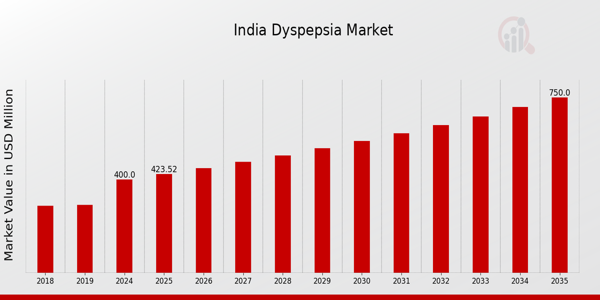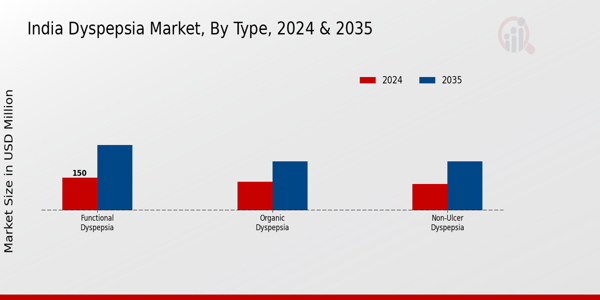India Dyspepsia Market Overview
The India Dyspepsia Market Industry is expected to grow from 400(USD Million) in 2024 to 750 (USD Million) by 2035. The India Dyspepsia Market CAGR (growth rate) is expected to be around 5.881% during the forecast period (2025 - 2035).
Key India Dyspepsia Market Trends Highlighted
The dynamics of the India Dyspepsia Market are being influenced by a number of main market drivers. The primary causes of the growing incidence of digestive disorders in India are the changing lifestyles, urbanization, and dietary preferences of the population. More individuals are experiencing dyspepsia symptoms due to the fast-paced nature of modern life and the increasing stress levels. Consequently, there is a demand for therapeutic solutions. The market is further supported by the increasing awareness of healthcare in the country, which encourages consumers to seek medical treatment for gastrointestinal issues.
The introduction of innovative treatment options and over-the-counter medications, which are becoming more accessible to the general population, are among the opportunities to be explored in the India Dyspepsia Market. Indian consumers are increasingly inclined toward traditional and alternative therapies to manage dyspepsia, which presents an opportunity for businesses to develop natural and herbal remedies in response to the increasing emphasis on preventive healthcare and holistic wellness. In recent years, there has been a significant increase in the use of digital platforms to access information about dyspepsia treatment and a trend toward self-medication.
A significant number of patients are currently utilizing telemedicine services and online health consultations to alleviate their symptoms, which underscores the increasing prevalence of digital healthcare solutions. Additionally, the significance of incorporating lifestyle modifications, such as diet and exercise, into treatment regimens is increasingly acknowledged, underscoring the necessity of a comprehensive approach to dyspepsia management in India.These trends and opportunities suggest that the market is dynamic and constantly changing, with substantial potential for expansion in the years ahead.

Source: Primary Research, Secondary Research, Market Research Future Database and Analyst Review
India Dyspepsia Market Drivers
Increasing Prevalence of Digestive Disorders
In India, the increasing prevalence of digestive disorders is a significant driver for the India Dyspepsia Market Industry. According to the Indian Society of Gastroenterology, approximately 25% of the Indian population suffers from various gastrointestinal issues, including dyspepsia. The rise in unhealthy lifestyle choices, dietary habits, and increased consumption of fast food has led to a higher incidence of digestive problems.
Furthermore, a study published in the Journal of Gastroenterology indicates that gastrointestinal diseases are rising at an alarming rate of 10% annually in urban areas.This trend creates a consequential demand for dyspepsia management solutions, including medications and therapies. As healthcare organizations such as the All India Institute of Medical Sciences continue to address these problems through awareness campaigns and research initiatives, the market for dyspepsia treatments is expected to grow. With a substantial population in need of effective treatment options, the India Dyspepsia Market is poised for remarkable expansion.
Rising Awareness of Gastrointestinal Health
The growing awareness regarding gastrointestinal health among the Indian populace significantly contributes to the India Dyspepsia Market Industry. Public health initiatives led by organizations like the Ministry of Health and Family Welfare have been instrumental in educating individuals about the importance of maintaining digestive health.
A survey conducted by the National Health Mission highlighted that around 60% of respondents have become more conscious about their dietary habits and the impact of those habits on their digestive well-being over the past five years.This increased awareness has fostered higher demand for dyspepsia treatments, as individuals seek to mitigate discomfort and improve their quality of life.
Advancements in Medical Treatments and Technologies
Innovations in medical treatments and technologies are another notable driver for the India Dyspepsia Market Industry. The development of new medications, such as proton pump inhibitors and H2 receptor antagonists, has greatly enhanced the management of dyspepsia. As reported by the Drug Controller General of India, the approval of over 25 new dyspepsia-related drugs in the last three years alone reflects the rapid advancement in this field.
Moreover, the introduction of non-invasive diagnostic technologies has made it easier for healthcare professionals to diagnose and treat dyspepsia.Organizations like the Indian Pharmaceutical Association play a pivotal role in supporting Research and Development initiatives that focus on improving therapies, which ultimately benefits patients throughout India.
India Dyspepsia Market Segment Insights
Dyspepsia Market Type Insights
The India Dyspepsia Market, particularly around the Type segment, showcases a diverse landscape characterized by its various forms such as Functional Dyspepsia, Non-Ulcer Dyspepsia, and Organic Dyspepsia. This segmentation is crucial in understanding the nuanced nature of dyspepsia symptoms, which can range from discomfort to severe gastric issues, impacting a significant portion of the Indian population. Functional Dyspepsia, for instance, often arises without a recognizable organic cause, making diagnosis a challenge, but it remains a leading form due to lifestyle factors prevalent in India, such as dietary habits and stress. Meanwhile, Non-Ulcer Dyspepsia includes symptoms similar to those of ulcers, yet traditional endoscopic evaluation does not reveal any ulcers. Despite the absence of visible disease, the psychological component of this dyspepsia type is gaining increasing recognition, as mental health plays a significant role in digestive health among the Indian populace.
This has led to a growing demand for therapeutic solutions that address both physical and psychological aspects of gastrointestinal distress. In the case of Organic Dyspepsia, this involves significant underlying health issues, where conditions such as peptic ulcers or gastroesophageal reflux disease contribute to the dyspeptic symptoms. This type accounts for a smaller portion of the overall market but is vital for clinical approaches, as proper management of these underlying conditions can vastly improve patient quality of life.
Overall, understanding the nuances of the India Dyspepsia Market segmentation not only aids healthcare providers in offering targeted treatment options but also empowers patients with knowledge about their conditions, contributing to increased market growth and improved healthcare outcomes. There is increasing awareness and education on dyspeptic symptoms, leading to earlier diagnosis and better management strategies, which ultimately supports the expansion of various healthcare practices and pharmaceutical developments catering to this market.

Source: Primary Research, Secondary Research, Market Research Future Database and Analyst Review
Dyspepsia Market Treatment Type Insights
The India Dyspepsia Market, particularly within the Treatment Type segment, is experiencing significant growth driven by a rising prevalence of dyspeptic symptoms among the population. The market is characterized by various treatment options, including Antacids, Proton Pump Inhibitors, H2-Receptor Antagonists, and Prokinetics, each playing a crucial role in symptom relief and management. Among these, Antacids are often the first-line treatment due to their immediate effect on acidity and discomfort, making them widely popular.
Proton Pump Inhibitors, known for their ability to provide long-term relief by reducing gastric acid production, have gained traction as more patients seek sustainable treatment options.H2-Receptor Antagonists also hold importance as they help manage symptoms efficiently, while Prokinetics support digestive processes and can assist in enhancing gastrointestinal motility. The increasing awareness of gastroenterological health, coupled with changing lifestyle habits, propels the demand for effective treatment. Moreover, improvements in healthcare access and a growing middle class in India are influencing consumer preferences and driving the overall market forward. As such, this Treatment Type segment showcases diverse options, responding to the needs of a sizeable dyspeptic population in India.
Dyspepsia Market Route of Administration Insights
The Route of Administration segment in the India Dyspepsia Market encompasses various methods through which medications are delivered to patients, including Oral, Injectable, and Topical routes. Oral administration is the most widely used method due to its convenience and patient preference, allowing for easy self-administration and broader accessibility of dyspepsia treatments. Injectable forms, while less common, play a crucial role in cases where rapid onset of action is required, or in patients unable to take medications orally, showcasing their significance in immediate therapeutic intervention.
On the other hand, topical applications provide localized treatment options, which are essential for managing symptoms like gastritis and reflux while minimizing systemic side effects. As India continues to gear towards advancements in pharmaceutical technologies and increasing healthcare awareness, the Route of Administration in the India Dyspepsia Market is reflecting a notable trend of diversification that aligns with patient needs and preferences, supporting a dynamic and evolving industry landscape.
Dyspepsia Market Distribution Channel Insights
The Distribution Channel segment of the India Dyspepsia Market plays a crucial role in ensuring that patients have access to medication and treatment options. Hospital pharmacies serve as a vital link for patients receiving inpatient care, offering tailored pharmaceutical services that enhance patient outcomes and recovery. Retail pharmacies, on the other hand, hold a significant share of the market by providing convenient access to dyspepsia medications in urban and rural areas; this accessibility supports the ongoing demand and reflects the reliance of consumers on neighborhood pharmacies for immediate healthcare needs.
Meanwhile, online pharmacies are witnessing rapid growth, driven by increasing internet penetration and a shift towards digital healthcare solutions, especially in metropolitan regions. The market is influenced by factors such as the rising prevalence of dyspepsia symptoms, consumer preference for convenient purchasing options, and the increasing health-consciousness among the Indian population. The trends indicate shifting consumer behavior toward online platforms, thus presenting new opportunities for growth within the market. Overall, the Distribution Channel segment remains pivotal in shaping the landscape of the India Dyspepsia Market by meeting diverse patient needs across different purchasing channels.
India Dyspepsia Market Key Players and Competitive Insights
The competitive landscape of the India Dyspepsia Market has evolved significantly in recent years, shaped by the rising prevalence of gastrointestinal disorders among the Indian population. Factors such as lifestyle changes, dietary habits, and increased stress levels contribute to the increased incidence of dyspepsia, subsequently driving demand for effective treatment options. The market is characterized by a multitude of players, ranging from multinational pharmaceutical companies to local generic manufacturers. Competition within this sector is intense, with firms continuously innovating their formulations, enhancing distribution networks, and crafting targeted marketing strategies to capture a larger share of the growing market. The players in this arena are focusing not only on enlarging their product offerings but also on improving their brand positioning to cater to the diverse needs of consumers across various demographics.
Pfizer is a prominent player in the India Dyspepsia Market, leveraging its renowned global reputation to establish trust among healthcare providers and patients alike. The company's strong presence in India is supported by a robust portfolio of gastrointestinal products, including well-established prescriptions that address various dyspeptic conditions. Pfizer's commitment to quality and research has enabled it to maintain a competitive edge, making it a trusted name within the market. Notably, their emphasis on patient education and awareness campaigns aims to help individuals understand dyspepsia's symptoms and treatment options, driving higher product adoption. Furthermore, Pfizer’s strategic collaborations with healthcare professionals and its active engagement in clinical research have fortified its position, ensuring it remains at the forefront of advancements in dyspepsia treatment.Lupin holds a significant position in the India Dyspepsia Market, renowned for its wide range of pharmaceuticals catering to gastrointestinal disorders. The company offers a variety of key products that address common dyspeptic symptoms, reinforcing its appeal among medical professionals and patients.
Lupin's strong distribution network across urban and rural areas allows for effective penetration, ensuring that their products are accessible to a larger audience. The company is noted for its focus on innovation and affordability, which helps to position its offerings as cost-effective alternatives in a competitive landscape. Additionally, Lupin has engaged in strategic mergers and acquisitions to bolster its portfolio in the gastrointestinal arena, enhancing its capabilities and product range. This focus on expanding its footprint, combined with a commitment to high-quality standards, strengthens Lupin's competitive advantage in the dyspepsia market in India, allowing it to respond adeptly to changing consumer needs and evolving market dynamics.
Key Companies in the India Dyspepsia Market Include:
- Pfizer
- Lupin
- Dr. Reddy's Laboratories
- Abbott
- Mylan
- Bayer
- GlaxoSmithKline
- Hetero Drugs
- Cipla
- Wockhardt
- Torrent Pharmaceuticals
- Asterisk Pharmaceuticals
- Alkem Laboratories
- Sun Pharmaceutical Industries
- Zydus Cadila
India Dyspepsia Market Industry Developments
In recent months, the India Dyspepsia Market has seen significant developments, particularly with companies like Pfizer, Dr. Reddy's Laboratories, and Abbott expanding their product lines. Notably, the market has been impacted by a growing awareness of gastrointestinal disorders among the Indian population, boosted by initiatives promoting health awareness by governmental organizations. In September 2023, Lupin launched a novel drug formulation aimed at addressing dyspepsia symptoms, enhancing its competitive edge.
The market valuation for major players like Cipla and Sun Pharmaceutical Industries has demonstrated growth, reflecting increased healthcare expenditure in India, which stood at around 3.1% of the GDP in 2022 according to the Ministry of Health and Family Welfare.
Additionally, there have been no significant mergers or acquisitions reported among the companies listed, suggesting a focus on internal product development rather than consolidation. In the past couple of years, April 2022 saw GlaxoSmithKline investing in local clinical trials to optimize treatments for dyspepsia, further solidifying the competitive environment in the Indian landscape.
India Dyspepsia Market Segmentation Insights
Dyspepsia Market Type Outlook
- Functional Dyspepsia
- Non-Ulcer Dyspepsia
- Organic Dyspepsia
Dyspepsia Market Treatment Type Outlook
- Antacids
- Proton Pump Inhibitors
- H2-Receptor Antagonists
- Prokinetics
Dyspepsia Market Route of Administration Outlook
Dyspepsia Market Distribution Channel Outlook
- Hospital Pharmacies
- Retail Pharmacies
- Online Pharmacies
| Report Attribute/Metric Source: |
Details |
| MARKET SIZE 2023 |
340.0(USD Million) |
| MARKET SIZE 2024 |
400.0(USD Million) |
| MARKET SIZE 2035 |
750.0(USD Million) |
| COMPOUND ANNUAL GROWTH RATE (CAGR) |
5.881% (2025 - 2035) |
| REPORT COVERAGE |
Revenue Forecast, Competitive Landscape, Growth Factors, and Trends |
| BASE YEAR |
2024 |
| MARKET FORECAST PERIOD |
2025 - 2035 |
| HISTORICAL DATA |
2019 - 2024 |
| MARKET FORECAST UNITS |
USD Million |
| KEY COMPANIES PROFILED |
Pfizer, Lupin, Dr. Reddy's Laboratories, Abbott, Mylan, Bayer, GlaxoSmithKline, Hetero Drugs, Cipla, Wockhardt, Torrent Pharmaceuticals, Asterisk Pharmaceuticals, Alkem Laboratories, Sun Pharmaceutical Industries, Zydus Cadila |
| SEGMENTS COVERED |
Type, Treatment Type, Route of Administration, Distribution Channel |
| KEY MARKET OPPORTUNITIES |
Innovative diagnostic tools, Rising health awareness, Herbal remedies demand, Personalized treatment options, Telehealth integration for consultations |
| KEY MARKET DYNAMICS |
rising prevalence of lifestyle diseases, increasing demand for OTC medications, growing awareness of digestive health, government initiatives for healthcare access, expanding healthcare infrastructure in rural areas |
| COUNTRIES COVERED |
India |
Frequently Asked Questions (FAQ):
The India Dyspepsia Market is expected to be valued at 400.0 million USD in 2024.
By 2035, the India Dyspepsia Market is projected to reach a value of 750.0 million USD.
The expected CAGR for the India Dyspepsia Market from 2025 to 2035 is 5.881%.
The market includes Functional Dyspepsia, Non-Ulcer Dyspepsia, and Organic Dyspepsia.
Functional Dyspepsia is the highest valued segment at 150.0 million USD in 2024.
The Non-Ulcer Dyspepsia segment is expected to grow to 225.0 million USD by 2035.
Key players include Pfizer, Lupin, Dr. Reddy's Laboratories, Abbott, Mylan, and several others.
The forecasted market value for Organic Dyspepsia by 2035 is 225.0 million USD.
In 2024, the Functional Dyspepsia segment holds a market value of 150.0 million USD.
Opportunities include increasing awareness, improving diagnosis, and advancements in treatment options.





















